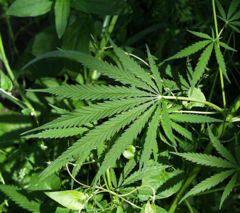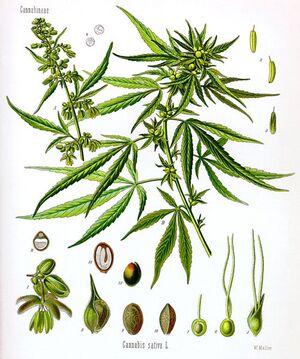Cannabis sativa
| Cannabis sativa subsp. var. | ||||||||||||||||||||||||||||||||||||||||||||||||||||||||
|---|---|---|---|---|---|---|---|---|---|---|---|---|---|---|---|---|---|---|---|---|---|---|---|---|---|---|---|---|---|---|---|---|---|---|---|---|---|---|---|---|---|---|---|---|---|---|---|---|---|---|---|---|---|---|---|---|

|
|
| ||||||||||||||||||||||||||||||||||||||||||||||||||||||
| ||||||||||||||||||||||||||||||||||||||||||||||||||||||||
Cannabis sativa is an annual plant in the Cannabaceae family. It is an herb that has been used throughout recorded history by humans as a source of fiber, for its seed oil, as food (see hemp), as a drug, as medicine, and for spiritual purposes. Each part of the plant is harvested differently, depending on the purpose of its use.
Cultivation

The flowers of the female plant are arranged in racemes and can produce hundreds of seeds. Male plants shed their pollen and die several weeks prior to seed ripening on the female plants. Although genetic factors dispose a plant to become male or female, environmental factors including the diurnal light cycle can alter sexual expression.[citation needed] Naturally occurring monoecious plants, with both male and female parts, are either sterile or fertile but artificially induced "hermaphrodites" (a commonly used misnomer) can have fully functional reproductive organs. "Feminized" seed sold by many commercial seed suppliers are derived from artificially "hermaphrodytic" females that lack the male gene, or by treating the seeds with hormones or silver thiosulfate.
A Cannabis plant in the vegetative growth phase of its life requires more than 12–13 hours of light per day to stay vegetative. Flowering usually occurs when darkness equals at least 12 hours per day. The flowering cycle can last anywhere between five to ten weeks, depending on the strain and environmental conditions.
In soil, the optimum pH for the plant is 6.3 to 6.8. In hydroponic growing, the nutrient solution is best at 5.2 to 5.8, making Cannabis well-suited to hydroponics because this pH range is hostile to most bacteria and fungi.
- Cultivars primarily cultivated for their fiber, characterized by long stems and little branching.
- Cultivars grown for seed from which hemp oil is extracted.
- Cultivars grown for medicinal or recreational purposes. A nominal if not legal distinction is often made between industrial hemp, with concentrations of psychoactive compounds far too low to be useful for that purpose, and marijuana.
Propagation
Pests and diseases
Varieties
Subspecies:
- C. sativa L. subsp. sativa
- C. sativa L. subsp. indica
Gallery
-
photo 1
-
photo 2
-
photo 3
References
External links
- w:Cannabis sativa. Some of the material on this page may be from Wikipedia, under the Creative Commons license.
- Cannabis sativa QR Code (Size 50, 100, 200, 500)
